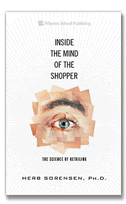A lot of the inadequacy seen in shopper research comes from an incomplete understanding of the basic components of the in-store trip. For this Views I will share the paradigm that has grown from our many years of observing, measuring shopping trips and, when useful, interviewing shoppers as they conduct their trips within the four walls of the store.
Overhead
Some portion of every shopping trip can reasonably be considered "overhead," because it does not directly contribute to purchasing behavior, the presumptive purpose of the trip - but not necessarily the only purpose.
First, there is the in-store preshop when the shopper first enters the store, and typically goes through an orientation phase, possibly obtaining a cart or basket, and otherwise orienting themselves before launching into the trip. This activity often occurs in an area we sometimes refer to as the "landing zone," the first point of pause within the store.
There may be other times in the trip which provide purchasing interludes - stop for a snack, social conversation with another shopper, visit to the restroom, etc. This type of overhead serves as punctuation for the trip.
Finally, there is the denouement of the trip when the shopper arrives at the check-stand to pay and exit. Even though purchases at the checkout are obviously of great significance to categories represented there, the shopping there differs qualitatively from the rest of the store. This combined with the fact that only a small share of the perhaps 80% of trips that pass through, actually buy something here, we ordinarily consider this portion of the trip as overhead. (The "80%" recognizes that not all who pass through the store, also pass through the checkstand.)
There is another complication to considering everything happening after arriving at the checkstand as overhead, and that is the increased focus on what is referred to as "the fifth wall." This is the wall beyond the checkout where there is often a customer service counter where a variety of purchases may occur, as well as banking, video rentals, or any number of other purchase opportunities that may represent significant profit opportunities for suppliers and retailers.
In the future, various technologies may obviate the checkout process nearly entirely, virtually eliminating the checkout "wall," so that the "fifth wall" may take on even more significance.
Search and Select
Purchase activity can be divided into search and selection, with search having two components, the first of which is cruising, which consists of a macro search for the area in the store where sought merchandise is located. This cruising typically constitutes something like 60% of the shoppers trip, and is discussed in the Wharton paper, The 'Traveling Salesman' Goes Shopping, by Fader, Bradlow and Hui.
Once the shopper has arrived in the general area of a purchase they stop cruising per se, and move to scanning the shelves in search of the category/subcategory where a selection of candidate items is displayed.
Once their focus is on their consideration set, there is less physical movement and the shopper zooms in on that set of items that will deliver their actual purchase, with a series of fixations that ultimately deliver the purchase (or not!)
The search and select paradigm highlights the twin barriers to purchase that retailers and their brand suppliers erect:
- Where is the . . ?
- Which one of these . . ?
The first of these plagues the shopper when store layout does not match the shopper's natural navigational practices and the second when it is unclear which of many options is the right one for the shopper.
This search and select outline describes the sales process from the shopper's point of view. Although distinctive from the shopper's view, the selling point of view overlays this quite well, beginning with the necessity of Reaching the shopper with the merchandise. This complements the shopper's search. But by focusing on getting product and shopper together by reaching the shopper, the perspective shifts the responsibility to the seller, instead of the buyer. There is genuine gold in that shift in perspective.
Once the merchandise reaches the shopper, (alternatively, the shopper visits the products,) two critical properties of the product must induce the sale: Stopping Power brings the shopper search to a halt (or slow.) This is the end of the cruising discussed above and the transition represented by the zoom to a consideration set. Where reach is something the retailer must provide, the product must speak for itself to stop the shopper and engage them in consideration.
However, the only purpose of consideration is to make the sale, a capability represented by Closing Power. Closing power is the single most important property any package/product can have, because no matter how much reaching and stopping occur, if no closing occurs, it is all to no avail. Remember, "close early and close often," and "The faster you close, the more you will sell!"
This brings us to the concept of Holding Power, which is the ability of a product to engage a shopper in a lengthy(?) conversation. Salesmen with pleasant conversational skills may be socially welcome, but unlikely to be competitive with real salesmen, who are always closers. Although some minimum holding power is prerequisite to selling, unless the product purchase has a heavy hedonic component (very unlikely,) seeking holding power in a product is more likely seeking to obfuscate the conversation with the shopper, the longer they are held, the less likely to close.
In the title here I included "so far!" because the schema or paradigm described here continues to evolve with advancing understanding. But unless you are well in advance, this wouldn't be a bad place to begin. :>)


